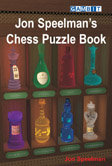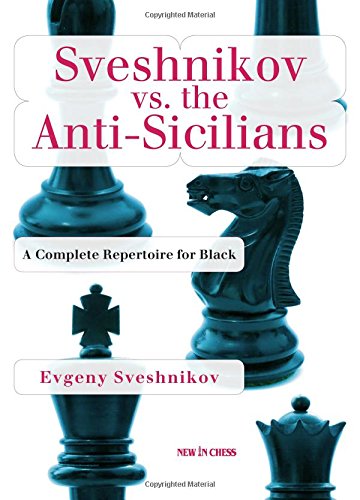 It is an excellent package overall and would make an ideal complement to an elementary textbook on tactics. You could think of it as being a kind of missing workbook. By diligently attempting to solve each position you will undoubtedly increase your tactical skill.
It is an excellent package overall and would make an ideal complement to an elementary textbook on tactics. You could think of it as being a kind of missing workbook. By diligently attempting to solve each position you will undoubtedly increase your tactical skill.
Tag: chess
A review of Sveshnikov vs. the Anti-Sicilians: A Complete Repertoire for Black by Evgeny Sveshnikov
 Some 75 theoretically significant games are presented in full, with many featuring Sveshnikov. There are 36 exercises, involving positional and strategic questions as well as tactical puzzles, with full solutions to follow. Apart from one chapter – there are far better ways to meet the Morra than to adopt the remedies given here, in my view – I found Sveshnikov’s analyses impressive.
Some 75 theoretically significant games are presented in full, with many featuring Sveshnikov. There are 36 exercises, involving positional and strategic questions as well as tactical puzzles, with full solutions to follow. Apart from one chapter – there are far better ways to meet the Morra than to adopt the remedies given here, in my view – I found Sveshnikov’s analyses impressive.
A review of The 3…Qd8 Scandinavian: Simple and Strong by Daniel Lowinger
 Daniel Lowinger makes a good case for an intriguing line of the Scandinavian (1.e4 d5 2.exd5 Qxd5 3.Nc3 Qd8), a favourite of GMs Josif Dorfman, Nikola Djukic and David Garcia. He argues that White’s knight is, or may easily become, misplaced on c3 and will probably have to move later. Therefore the loss of time involved in retreating the queen to its original square will be recuperated.
Daniel Lowinger makes a good case for an intriguing line of the Scandinavian (1.e4 d5 2.exd5 Qxd5 3.Nc3 Qd8), a favourite of GMs Josif Dorfman, Nikola Djukic and David Garcia. He argues that White’s knight is, or may easily become, misplaced on c3 and will probably have to move later. Therefore the loss of time involved in retreating the queen to its original square will be recuperated.
Chess Training for Post-Beginners A Basic Course in Positional Understanding by Yaroslav Srokovski
 Twelve chapters, each devoted to a particular positional element: the open file, strong and weak squares, the passed pawn, good knight versus bad bishop (and vice versa), etc. A few classic examples, naturally, but modern games predominate. Yaroslav Srokovski’s annotations are instructive, not least because they are refreshingly objective for textbooks of this sort.
Twelve chapters, each devoted to a particular positional element: the open file, strong and weak squares, the passed pawn, good knight versus bad bishop (and vice versa), etc. A few classic examples, naturally, but modern games predominate. Yaroslav Srokovski’s annotations are instructive, not least because they are refreshingly objective for textbooks of this sort.
A review of Mikhail Botvinnik The Life and Games of a World Chess Champion by Andrew Soltis
 We learn many things about him that we did not know but might well have guessed. For example, that he did his own ironing and was a demon declutterer. He had no qualms about throwing things away if he hadn’t used them for a period of years, reasoning that he didn’t really need them. ‘He couldn’t abide disorder,’ says his daughter. ‘His home had to be clean and everything in its place.’
We learn many things about him that we did not know but might well have guessed. For example, that he did his own ironing and was a demon declutterer. He had no qualms about throwing things away if he hadn’t used them for a period of years, reasoning that he didn’t really need them. ‘He couldn’t abide disorder,’ says his daughter. ‘His home had to be clean and everything in its place.’
A review of The Benko Gambit: Move by Move by Junior Tay
 The Benko Gambit gives Black early pressure on the queenside and an initiative that often persists well into the endgame, a practical advantage being that Black’s position is generally easier to play. On the whole, the investment of a pawn represents good value.
The Benko Gambit gives Black early pressure on the queenside and an initiative that often persists well into the endgame, a practical advantage being that Black’s position is generally easier to play. On the whole, the investment of a pawn represents good value.
A review of 1001 Brilliant Ways to Checkmate by Fred Reinfeld and Bruce Alberston
 Fred Reinfeld’s venerable book, consisting of 1001 checkmate puzzles arranged by theme, has been edited and recast into algebraic notation by Bruce Albertson. Themes include the queen sacrifice, discovered check and double check, and pawn promotion; and only the last chapter, a collection of composed problems, seems out of place. What you have got otherwise are positions taken from actual games that are of, at most, a medium level of difficulty.
Fred Reinfeld’s venerable book, consisting of 1001 checkmate puzzles arranged by theme, has been edited and recast into algebraic notation by Bruce Albertson. Themes include the queen sacrifice, discovered check and double check, and pawn promotion; and only the last chapter, a collection of composed problems, seems out of place. What you have got otherwise are positions taken from actual games that are of, at most, a medium level of difficulty.
A review of San Remo 1930 International Chess Tournament by Robert Sherwood
 This is an excellent tournament book, which gives a genuine flavour of the chess milieu of the time. All the games are annotated, the vast majority by Robert Sherwood, though some by Alekhine, Nimzowitsch and other players and contemporary commentators.
This is an excellent tournament book, which gives a genuine flavour of the chess milieu of the time. All the games are annotated, the vast majority by Robert Sherwood, though some by Alekhine, Nimzowitsch and other players and contemporary commentators.
A review of Vassily Ivanchuk: 100 Selected Games by Nikolay Kalinichenko
 Kalinichenko presents a vivid portrait of this brilliant player, still active and creative in his mid-‘40s, and does a good job of making his inspirational games accessible to a wide audience.
Kalinichenko presents a vivid portrait of this brilliant player, still active and creative in his mid-‘40s, and does a good job of making his inspirational games accessible to a wide audience.
A review of Finding Chess Jewels by Michael Krasenkow
 Krasenkow’s introduction gives some thoughts and tips on how to analyse a position and calculate variations, both when solving puzzles and in an actual game, and this is followed by about 250 tactical exercises arranged in three sections. Most positions have the neutral instruction ‘White to Play’ or ‘Black to Play’ but very occasionally there is a more specific question for you to answer.
Krasenkow’s introduction gives some thoughts and tips on how to analyse a position and calculate variations, both when solving puzzles and in an actual game, and this is followed by about 250 tactical exercises arranged in three sections. Most positions have the neutral instruction ‘White to Play’ or ‘Black to Play’ but very occasionally there is a more specific question for you to answer.